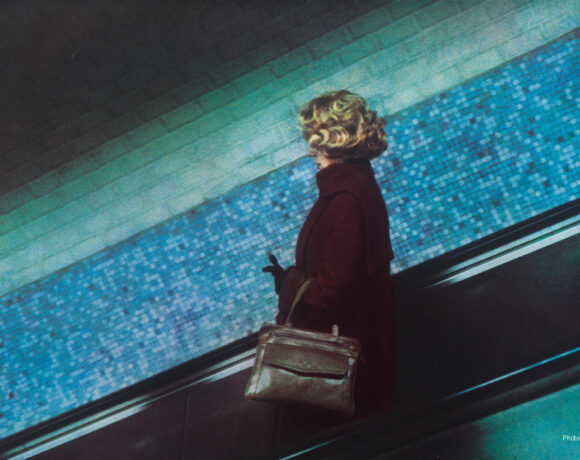The photos appear vivid and full of intense colours, framed by a blue background that amplifies the power of the images. The narration of the protagonists’ lives, flows before our eyes, as in a magnetic film from which we cannot look away. Each photo highlights an original aspect of this narrative, essential in its settings, but incredibly powerful. The greatest perceptible intensity lies in the fact that although it is a reportage from the end of the last century, the relevance of its language is entirely contemporary. Although this aspect is by no means taken for granted in most similar photographic works, it constitutes the main feature of Alessandra Sanguinetti’s practise, a well-known photojournalist who has been a member of the Magnum Agency since 2007, and who is committed to the iconographic documentation of the present.The focus of the exhibition “Les Aventures de Guille et Belinda” at Fondation Henri Cartier – Bresson is part of this vision of the photographer’s world and is centred on focusing on the lives of two friends, who share the wild spaces of a farm in Argentina, documenting the passage of time on their faces and bodies. The two girls are portrayed in moments of their everyday life, but as Sanguinetti’s work spans several years, the wild and natural environment is often enriched by sets designed by the photographer to give them movement and depth, succeeding in producing images that wink at classical art iconography. In “The Ophelias” (2002), for example, Guillermina and Belinda are portrayed floating on the surface of the water, wearing clothes that match the shades of blue in which they are immersed, holding colourful wild flowers. The image, which has an obvious reference to the painting by the Pre-Raphaelite painter John Everett Millais, on the whole renders the sense of fluctuations by being aesthetically harmonious and powerful, although the mise-en-scene gives an absolutely earthy dimension to the shot, compared to that of the painting.

Alessandra Sanguinetti, “The Ophelias”, 2002 © 2021 Alessandra Sanguinetti / Magnum Photos, courtesy Fondation Henri Cartier-Bresson, Paris
Guille and Belinda are no strangers to Sanguinetti, who, although born in New York, lived for a long time with her family on a ranch in Argentina, very similar to the one she describes in her photographs. The games of the two muses were since childhood cheered up by the presence of Alessandra (with her camera), who shared the love for animals of Juana, grandmother of the two protagonists, and relentlessly immortalised her granddaughters and their farm. From the outset, therefore, the documentation of everyday life, the feelings of the two cousins, but also the passage of time, changing femininity and life passing by with its characteristic elements, were the photographer’s spontaneous in-depth themes. Initially with a naive gaze, she later pursued them with greater rigour, choosing to abandon her first career as an anthropologist, to attend Icp in New York and later move to San Francisco. The photos in the exhibition follow one another in a chromatic chronology of intense tones. The settings overwhelmingly express their role, illustrating lush and impervious pampas that encompass and welcome the games of the two young girls. However, the focus of Sanguinetti’s work is ontologically more complex and deep, if one looks at it carefully. First of all, Argentina, known in the common imagination for its wild territory, for its immense boundless expanses, for the gauchos and their life as ranchers, but never linked to the female image. In this case, however, Guille and Belinda represent the other side of the same coin. Their simple games take place in the environment that had always been attributed to the male prerogative, sometimes even aping typical machismo, deconstructing its archetype. On the whole, Sanguinetti’s work evokes memories of the family photos of those who grew up in the same era, or perhaps a few years earlier, living in a natural environment devoid of sophisticated stimuli, in which the immediate relationship with animals, dressing up in grown-up clothes, role-playing or simply bathing in a pristine stream, was an usual expression of pure enjoyment. In this innovative and modern perspective, the bodies of the two girls and their change through the ages also assume considerable relevance. It is not insignificant to observe how, in an era that is absolutely far removed from body positivity and modern campaigns aimed at the acceptance of bodies which do not always conform to common judgement, the effigy of the two cousins, aesthetically very different from each other, not only does not appear out of context, but seems absolutely physiological to the environment and the story of the images, allowing physicality to take on the form that it has often lost in the glossy photos we are used to. The spontaneity of the protagonists pierces the screen, their confidence and joy spread through us, watching them free of external conditioning, even when their bodies face the changes of every woman, such as pregnancy or motherhood, sometimes experienced in a controversial way in contemporary times.

Alessandra Sanguinetti, “The Black Cloud”, 2001 © 2021 Alessandra Sanguinetti / Magnum Photos, courtesy Fondation Henri Cartier-Bresson, Paris
With the passage of time, Sanguinetti’s view of the world and events has also changed, and the story of Guille and Belinda is being enriched with new chapters. In fact, the Argentinean photographer is currently working on a series of films shot of Guillermina and Belinda in the same years in which the photos in the exhibition were produced, which could become video, introducing a different narrative of the reportage, another point of view on the story already told. At the same time, just as in the series of photos featured in the exhibition, the evolving concept of femininity of the two protagonists is highlighted, Sanguinetti, with her recent work, is putting forward a new image of the two women. In fact, Vogue Italia is celebrating the story of Guille and Belinda with a project in which the two muses appear as they are today, portrayed by Alessandra Sanguinetti in glamorous clothes, light years away from the wild naturalness of the photographs from the past.The images are now colourful and captivating, the two protagonists still look straight into the camera without uncertainty. Their bodies take on fluid poses, just as they did in a more minimal context when they were younger. The lives they have lived shape the current images of these two women, who, although their existence is full of events and emotions, have not lost their charm and aesthetic strength. The power of Sanguinetti’s images paints them in the present moment. Embodying contemporary roles, the two new Amazons of life in the 2000s carry on that famous storytelling that is so much talked about nowadays, that is an unmistakable stylistic feature of the Argentine photographer’s work.
Info:
Alessandra Sanguinetti. Les Aventures de Guille et Belinda
curated by: Clément Chéroux, director Fondation Henri Cartier-Bresson, Pierre Leyrat, exhibitions manager, Fondation Henri Cartier-Bresson
30/01/2024 – 19/05/2024
Fondation Henri Cartier-Bresson
79 Rue des Archives, 75003 Paris, Francia
www.henricartierbresson.org

Globetrotter, passionate about literature, lover of art and photography. I never leave for a trip without taking with me a book by an author of the place where I will go. I have dreamed of moving to Paris for years and sooner or later I will!






NO COMMENT